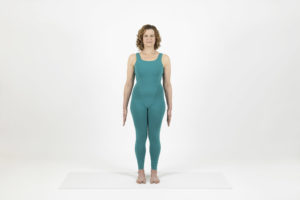
by Nina
Did you ever do a yoga practice that started out with a resting pose and ended with more active and stimulating poses?
Typically this isn’t the way we practice yoga poses here in the West. In almost all yoga classes I’ve ever taken, whether they’re given in the morning, afternoon, or evening, we started out with warm up poses, moved into active poses, cooled down from the active poses, and ended with a resting pose, which was almost always Savasana.
But that’s really just a convention. There’s no yoga “law” that says you have to sequence that way.
For example, many years ago I took a morning class from Mary Lou Weprin that ended with Mountain pose! I liked the way I felt so much after that class than from then on when I taught Saturday afternoon workshops with sequences of Supported Inverted poses, I would end the workshop with Mountain pose followed by a little Arms Overhead vinyasana to perk the students up a bit before they headed off into their Saturday night activities.
And when I was going through perimenopause and was frequently having what I called “fatigue attacks,” I used to practice the “Sequence for Fatigue” by Patricia Walden in the book The Woman’s Book of Yoga and Health. While that sequence begins with Reclined Cobbler’s pose, it is not just a series of restorative poses. Instead, after resting first in Reclined Cobbler’s pose, you move into more stimulating poses, including a seated twist, a Downward-Facing Dog pose, a Headstand, and so on. This rather long sequence did circle back to end with quieting poses, however, including both Legs Up the Wall pose and a final Savasana.
The point is, depending on your physical state on a given day, if you want to rest at the beginning of your practice, you can! Then you can ease into more active poses. And if you want to end your practice with something more energizing than Savasana, you can! I do think it’s beneficial for your body to end your practice with a neutral and symmetrical pose to consciously rebalance your body from any asymmetrical movements you did earlier in the practice, so that’s why I like Mountain pose for this purpose. But there may be other options instead.
In my book Yoga for Times of Change, I included a fatigue sequence of my own in the chapter “Moving Through Grief.” Although it was inspired by the one in The Woman’s Book of Yoga and Health, it is much shorter and more accessible. And I decided to end it with Mountain pose instead of Savasana so that after you have a good rest, you can energize yourself enough so you feel ready to tackle whatever is next on your to-do list. It seemed a bit like a radical idea, but Barrie told me that after practicing all the sequences in the book, this fatigue sequence was one of her favorites, especially when she’s feeling stressed or overwhelmed. She said, “I always feel better after I’ve done it and often am ready to do a more active practice.”
So I thought that sharing the thinking behind that fatigue sequence might inspire you to experiment with more unconventional sequences of your own.
P.S. Haha, now I’ve given myself an idea! Lately I’ve been meditating for half an hour every afternoon and I don’t know I guess I’m getting so good at it that by the end I’ve reached a very, very quiet state and afterward I don’t feel much like doing anything except maybe lying down. But, of course, like the rest of you, I have work to do and a household to take care of so I just kind of get on with it. But now, after writing this post, I’ve just decided that I’ll take my own advice and energize myself just a bit after my meditation session by doing Mountain pose with a gentle Arms Overhead vinyasa. It will be interesting to see how that goes.
• Follow Yoga for Healthy Aging on Facebook and follow Nina on Instagram • Order Yoga for Times of Change here and purchase the companion videos here • Order Yoga for Healthy Aging: A Guide to Lifelong Well-Being here.


Leave A Comment